Mapping the Sandy Beach Evolution Around Seaports at the Scale of the African Continent
Abstract
1. Introduction
2. Methods
2.1. Selection of African Seaports
2.2. Automated Beach Change Detection from Landsat Satellite Imagery
2.3. Mapping Characteristics of the Ports
2.3.1. LST Potential
2.3.2. Visible Sediment Sources and Sinks (Rivers and Inlets)
2.3.3. Natural Sheltering Setting
2.3.4. Visible Coastal Protection Structures
2.3.5. Port Breakwater Length
2.3.6. Port Construction Date
3. Results
3.1. Historic and Present Beach Changes around African Seaports
3.2. Mapping Driving Characteristics of Beach Changes around African Seaports
4. Discussion
4.1. Accuracy of the Beach Change Detection
- exact area of interest (AOI): the exact area of interest was often not indicated precisely in the available literature. Therefore, this information had to be derived manually from figures presented in these studies and may be subject to error.
- image acquisition dates: the image acquisition dates in our study did not always match the ones in the literature, because (1) the exact date of the image acquisition was not mentioned, (2) different satellite missions were used, or (3) insufficient cloud free Landsat images were available to generate composite images.
- transect definition: the location and orientation of the cross-shore transects that were used in literature to derive the coastline change rates were not always specified and, hence, could differ from the definitions that we used in our study.
- manual vs. automated coastline detection: most studies detected the coastlines manually from individual cloud free images. This is more sensitive to human errors and instantaneous water levels at the time of the image acquisition than the automated coastline detection from composite images that we applied.
- number of available images within the study period: most of the studies derived coastline trends from a limited number of images (i.e., order 2–5) using end point rates (EPR; using only the first and the last image). In contrast, we used an exponential or linear regression rate based on 10–100 times more images.
4.2. Isolating Port-Induced Coastline Changes from Other Causes
4.3. Implications for Present and Future African Seaports
4.4. Validity and Applicability of Coastline Evolution Drivers
4.5. Opportunities for Future Applications
5. Conclusions
Author Contributions
Funding
Conflicts of Interest
References
- United Nations Conference on Trade and Development (UNCTAD). Review of Martime Transport; United Nations: New York, NY, USA; Geneva, Switzerland, 2013. [Google Scholar]
- Odum, H.T.; Odum, B. Concepts and methods of ecological engineering. Ecol. Eng. 2003, 20, 339–361. [Google Scholar] [CrossRef]
- World Association for Waterborne Transport Infrastructure (PIANC). ‘Sustainable Ports’ a Guide for Port Authorities; PIANC: Brussels, Belgium, 2014. [Google Scholar]
- De Vriend, H.J.; Van Koningsveld, M.; Aarninkhof, S.G.J.; De Vries, M.B.; Baptist, M.J. Sustainable hydraulic engineering through building with nature. J. Hydro-Environ. Res. 2015, 9, 159–171. [Google Scholar] [CrossRef]
- Nebot, N.; Rosa-Jimenez, C.; Ninot, R.P.; Perea-Medina, B. Challenges for the future of ports. What can be learnt from the Spanish Mediterranean ports? Ocean Coast. Manag. 2017, 137, 165–174. [Google Scholar] [CrossRef]
- Pelnard-Considere, R. Essai de Theorie de L’evolution des Formes de Rivage en Plages de Sable et de Galets; Les Energies de la Mer: Compte Rendu Des Quatriemes Journees de L’hydraulique, Paris 13, 14 and 15 Juin 1956; Question III, rapport 1, 74-1-10; Société Hydrotechnique de France: Paris, France, 1956; pp. 289–298. [Google Scholar]
- Meinesz, A.; Lefevre, J.R.; Astier, J.M. Impact of coastal development on the infralittoral zone along the southeastern Mediterranean shore of continental France. Mar. Pollut. Bull. 1991, 23, 343–347. [Google Scholar] [CrossRef]
- Bruun, P. The development of downdrift erosion. J. Coast. Res. 1995, 11, 1242–1257. [Google Scholar]
- Wu, W. Coastline evolution monitoring and estimation—A case study in the region of Nouakchott, Mauritania. Int. J. Remote Sens. 2007, 28, 5461–5484. [Google Scholar] [CrossRef]
- Mangor, K.; Brøker, I.; Deigaard, R.; Grunnet, N. Bypass harbours at littoral transport coasts. In Proceedings of the PIANC MMX Congress, Liverpool, UK, 10–14 May 2010. [Google Scholar]
- Giardino, A.; Schrijvershof, R.; Nederhoff, C.; De Vroeg, H.; Brière, C.; Tonnon, P.-K.; Caires, S.; Walstra, D.; Sosa, J.; Van Verseveld, W. A quantitative assessment of human interventions and climate change on the West African sediment budget. Ocean. Coast. Manag. 2017, 156, 249–265. [Google Scholar] [CrossRef]
- Liu, L.; Xu, W.; Yue, Q.; Teng, X.; Hu, H. Problems and countermeasures of coastline protection and utilization in China. Ocean. Coast. Manag. 2018, 153, 124–130. [Google Scholar] [CrossRef]
- Williams, A.T.; Rangel-Buitrago, N.; Pranzini, E.; Anfuso, G. The management of coastal erosion. Ocean. Coast. Manag. 2018, 156, 4–20. [Google Scholar] [CrossRef]
- Santos-Ferreira, A.; Santosa, C.; Cabrala, M. Local hydrodynamics and the siltation of Vila Praia de Âncora harbor. Procedia Eng. 2015, 116, 932–938. [Google Scholar] [CrossRef]
- Sarma, K.G.S. Siltation and Coastal Erosion at Shoreline Harbours. Procedia Eng. 2015, 116, 12–19. [Google Scholar] [CrossRef]
- Goda, Y. Random Seas and Design of Maritime Structures; University of Tokyo Press: Tokyo, Japan, 1985. [Google Scholar]
- Kaki, C.; Laïbi, R.A.; Oyédé, L.M. Evolution of Beninese coastline from 1963 to 2005: Causes and consequences. Br. J. Environ. Clim. Chang. 2011, 1, 216–231. [Google Scholar] [CrossRef]
- Aly, M.H.; Giardino, J.R.; Klein, A.G.; Zebker, H.A. InSAR study of shoreline change along the Damietta Promontory, Egypt. J. Coast. Res. 2012, 28, 1263–1269. [Google Scholar] [CrossRef]
- Laïbi, R.A.; Anthony, E.J.; Almar, R.; Castelle, B.; Senechal, N.; Kestenare, E. Longshore drift cell development on the human-impacted Bight of Benin sand barrier coast, West Africa. J. Coast. Res. 2014, 78–83. [Google Scholar] [CrossRef]
- Almar, R.; Kestenare, E.; Reyns, J.; Jouanno, J.; Anthony, E.J.; Laibi, R.; Hemer, M.; Du Penhoat, Y.; Ranasinghe, R. Response of the Bight of Benin (Gulf of Guinea, West Africa) coastline to anthropogenic and natural forcing. Part 1: Wave Climate variability and impacts on the longshore sediment transport. J. Cont. Shelf Res. 2015, 110, 48–59. [Google Scholar] [CrossRef]
- Kassi, A.J.-B.; Affo Djobo, A.; Kouame, A.K.D. Comparative Analysis of DSAS and MobiTC in Coastal Coastline Dynamics of Baguida and Agbodrafo Cantons (South-East Togo) from 1986 to 2017. Int. J. Comput. Trends Technol. 2018, 56, 32–37. [Google Scholar] [CrossRef]
- Gorelick, N.; Hancher, M.; Dixon, M.; Ilyushchenko, S.; Thau, D.; Moore, R. Google Earth Engine: Planetary-scale geospatial analysis for everyone. Remote Sens. Environ. 2017, 202, 18–27. [Google Scholar] [CrossRef]
- Hagenaars, G.; De Vries, S.; Luijendijk, A.P.; De Boer, W.P.; Reniers, A.J.H.M. On the accuracy of automated shoreline detection derived from satellite imagery: A case study of the Sand Motor mega-scale nourishment. Coast. Eng. 2018, 133, 113–125. [Google Scholar] [CrossRef]
- Luijendijk, A.; Hagenaars, G.; Ranasinghe, R.; Baart, F.; Donchyts, G.; Aarninkhof, S. The State of the World’s Beaches. Nat. Sci. Rep. 2018, 8. [Google Scholar] [CrossRef]
- Bruun, P.; Gerritsen, F. Stability of Coastal Inlets; North-Holland Publishing Co.: Amsterdam, The Netherlands, 1960; p. 123. [Google Scholar]
- Hayes, M.O. General morphology and sediment patterns in tidal inlets. Sediment. Geol. 1980, 26, 139–156. [Google Scholar] [CrossRef]
- Hayes, M.O.; FitzGerald, D.M. Origin, Evolution, and Classification of Tidal Inlets. J. Coast. Res. 2013, 69, 14–33. [Google Scholar] [CrossRef]
- McSweeney, S.L.; Kennedy, D.M.; Rutherfurd, I.D.; Stout, J.C. Intermittently Closed/Open Lakes and Lagoons: Their global distribution and boundary conditions. Geomorphology 2017, 292, 142–152. [Google Scholar] [CrossRef]
- National Geospatial-Intelligence Agency. World Port. Index; National Geospatial-Intelligence Agency: Springfield, VA, USA, 2017.
- Google Earth Pro. Available online: http://www.google.com/earth/index.html (accessed on 18 August 2018).
- McFeeters, S.K. The use of the normalized difference water index (ndwi) in the delineation of open water features. Int. J. Rem. Sens. 1996, 17, 1425–1432. [Google Scholar] [CrossRef]
- Otsu, N.A. A Threshold Selection Method from Gray-Level Histograms. IEEE Trans. Syst. Man Cybern. 1979, 9, 62–66. [Google Scholar] [CrossRef]
- Hansen, M.C.; Potapov, P.V.; Moore, R.; Hancher, M.; Turubanova, S.A.; Tyukavina, A.; Thau, D.; Stehman, S.V.; Goetz, S.J.; Loveland, T.R.; et al. High-resolution global maps of 21st-century forest cover change. Science 2013, 342, 850–853. [Google Scholar] [CrossRef]
- Donchyts, G.; Baart, F.; Winsemius, H.; Gorelick, N.; Kwadijk, J.; Van De Giesen, N. Earth’s surface water change over the past 30 years. Nat. Clim. Chang. 2016, 6, 810–813. [Google Scholar] [CrossRef]
- Wang, L.; Hou, C.; Li, P.; Qu, H.; Zhang, J. Study on Rocky Coastline Extraction of High-Spatial-Resolution Remote Sensing Images. In Proceedings of the International Conference on Computer and Information Technology Application, Shenzhen, China, 18–19 April 2016. [Google Scholar] [CrossRef]
- Harris, I.; Jones, P.D.; Osborn, T.J.; Lister, D.H. Updated high-resolution grids of monthly climatic observations—The CRU TS3.10 Dataset. Int. J. Climatol. 2014, 34, 623–642. [Google Scholar] [CrossRef]
- Stive, M.J.F.; Aarninkhof, S.G.J.; Hamm, L.; Hanson, H.; Larson, M.; Wijnberg, K.M.; Nicholls, R.J.; Copabianco, M. Variability of shore and shoreline evolution. Coast. Eng. 2002, 47, 211–235. [Google Scholar] [CrossRef]
- Dee, D.P.; Uppala, S.M.; Simmons, A.J.; Berrisford, P.; Poli, P.; Kobayashi, S.; Andrae, U.; Balmaseda, M.A.; Balsamo, G.; Bauer, P.; et al. The ERA-Interim reanalysis: Configuration and performance of the data assimilation system. Q.J.R. Meteorol. Soc. 2011, 137, 553–597. [Google Scholar] [CrossRef]
- U.S. Army Corps of Engineers. Shore Protection Manual, 4th ed.; Coastal Engineering Research Center, Department of the Army: Waterways Experiment Station, Corps of Engineers; Coastal Engineering Research Center: Vicksburg, MI, USA, 1984. [Google Scholar]
- Eko Atlantic. Available online: https://www.ekoatlantic.com/ (accessed on 20 December 2018).
- Van Rijn, L.C. Principles of Coastal Morphology; Aqua Publications: Amsterdam/Oldemarkt, The Netherlands, 1998. [Google Scholar]
- Kamphuis, J.W. Introduction to Coastal Engineering and Management; World Scientific: Singapore, 2010. [Google Scholar]
- U.S. Army Corps of Engineers. Coastal Engineering Manual (CEM), Engineer Manual 1110-2-1100; U.S. Army Corps of Engineers: Washington, DC, USA, 2002.
- Elmoustapha, A.O.; Levoy, F.; Monfort, O.; Koutitonsky, V.G. A Numerical Forecast of Shoreline Evolution after Harbour Construction in Nouakchott, Mauritania. J. Coast. Res. 2007, 23, 1409–1417. [Google Scholar] [CrossRef]
- El-Asmar, H.M. Short Term Coastal Changes Along Damietta-Port Said Coast Northeast of the Nile Delta, Egypt. J. Coast. Res. 2002, 18, 433–441. [Google Scholar] [CrossRef]
- Akinluyi, F.O.; Adebola, A.O.; Adeseko, A.A. Assessment of Shorelines and Associated Landuse/Land cover Changes alng Part of Lagos Coastline, Nigeria. Contemp. Trends. Geeosci. 2018, 7, 59–70. [Google Scholar] [CrossRef]
- Nassar, K.; Mahmod, W.E.; Fath, H.; Masria, A.; Nadaoka, K.; Negm, A. Shoreline change detection using DSAS technique: Case of North Sinai coast, Egypt. Mar. Georesources Geotechnol. 2019, 37, 81–95. [Google Scholar] [CrossRef]
- Wognin, A.I.V.; Coulibaly, A.S.; Akobe, A.C.; Monde, S.; Aka, K. Morphologie du littoral et cinématique du trait de côte de Vridi à Grand-Bassam (Côte d’Ivoire). J. Environ. Hydrol. 2013, 21, 1–10. [Google Scholar]
- Touré, B.; Kouamé, K.F.; Souleye, W.; Collet, C.; Affian, K.; Ozer, A.; Rudant, J.P.; Biémi, J. L’influence des actions anthropiques dans l’évolution historique d’un littoral sableux à forte dérive sédimentaire: La baie de Port-Bouët (Abidjan, Côte d’Ivoire). Géomorphologie Relief Process. Environ. 2012, 18, 369–382. [Google Scholar] [CrossRef][Green Version]
- Jerling, H.L. The Zooplankton Community of the Mhlathuze (Richards Bay) Estuary: Two Decades After Construction of the Harbour. Afr. J. Mar. Sci. 2003, 25, 289–299. [Google Scholar] [CrossRef][Green Version]
- Bruun, P.; Willekes, G. Bypassing and backpassing at Harbors, Navigation Channels, and Tidal Entrances: Use of Shallow-Water Draft Hopper Dredgers with Pump-Out Capabilities. J. Coast. Res. 1992, 8, 972–977. [Google Scholar]
- Cox, R.; Howe, D. Tweed River entrance and bypass sediment dynamics. In Proceedings of the International Conference on Coastal Engineering, Santander, Spain, 1–6 July 2012. [Google Scholar]
- Zwaborn, J.A.; Fromme, G.A.W.F.; FitzPatrick, J.B. Underwater mound for the protection of Durban’s beaches. In Proceedings of the Conference on Coastal Engineering, Washington, DC, USA, 13–18 September 1970; pp. 975–994. [Google Scholar] [CrossRef]

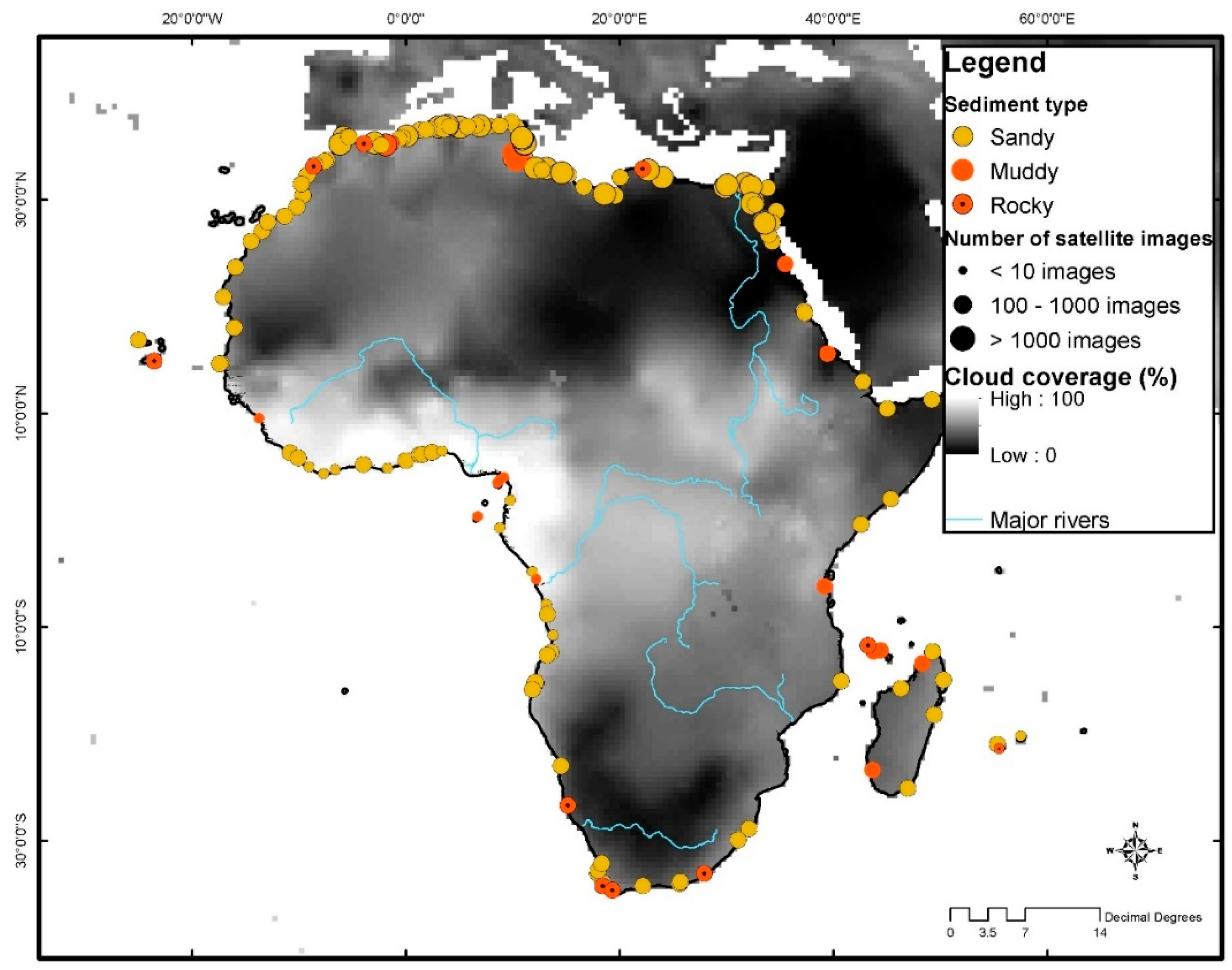
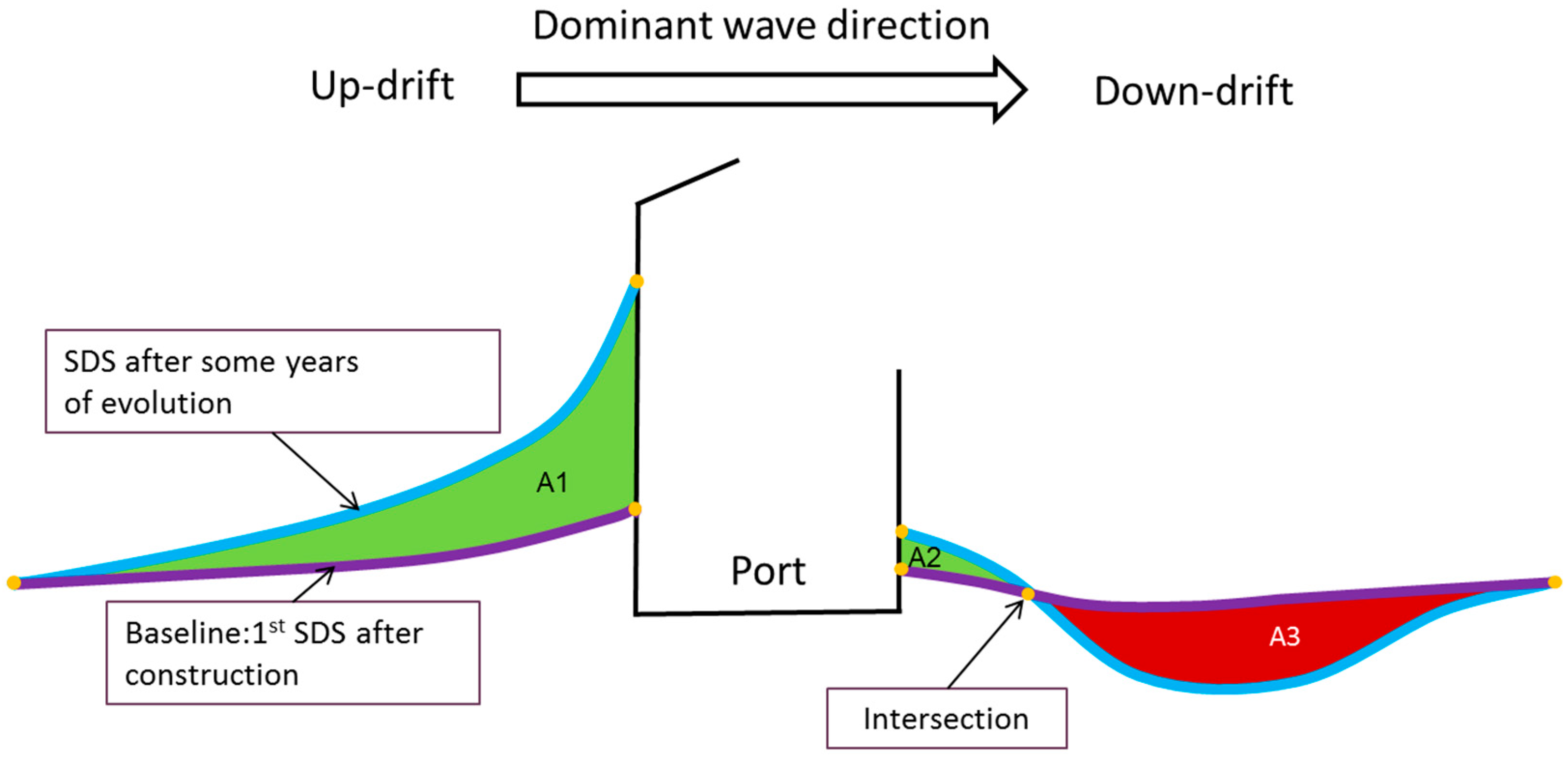
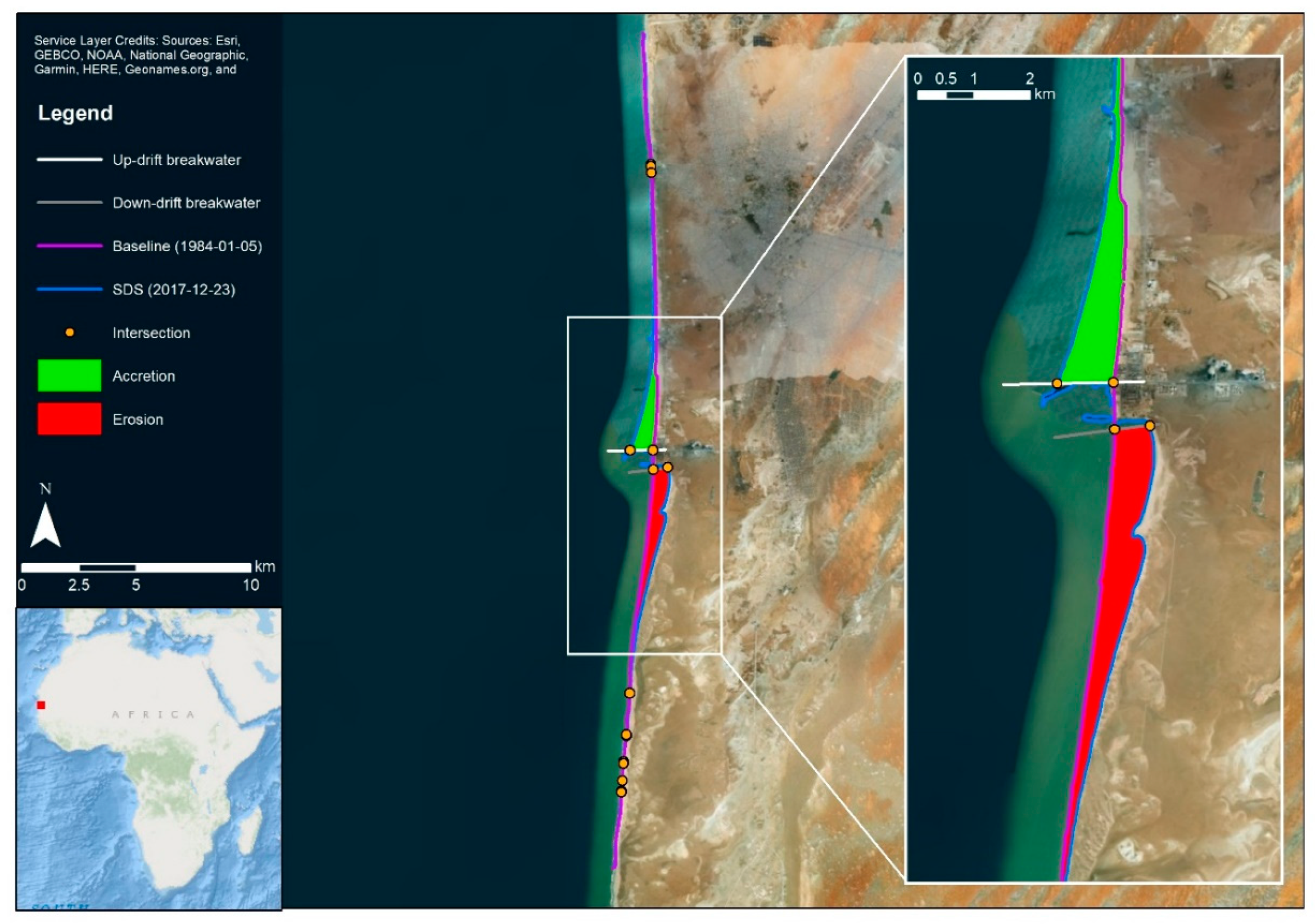
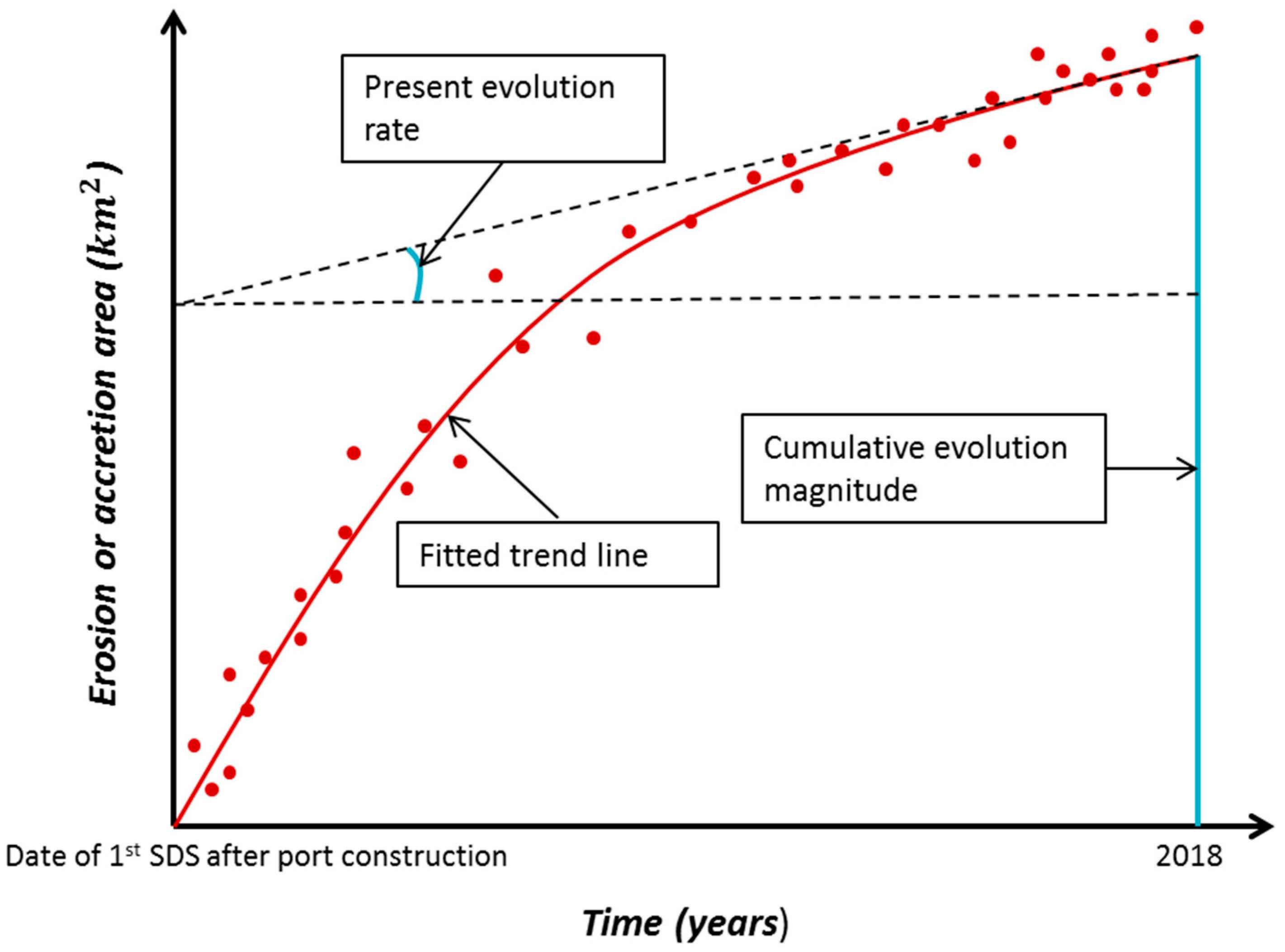
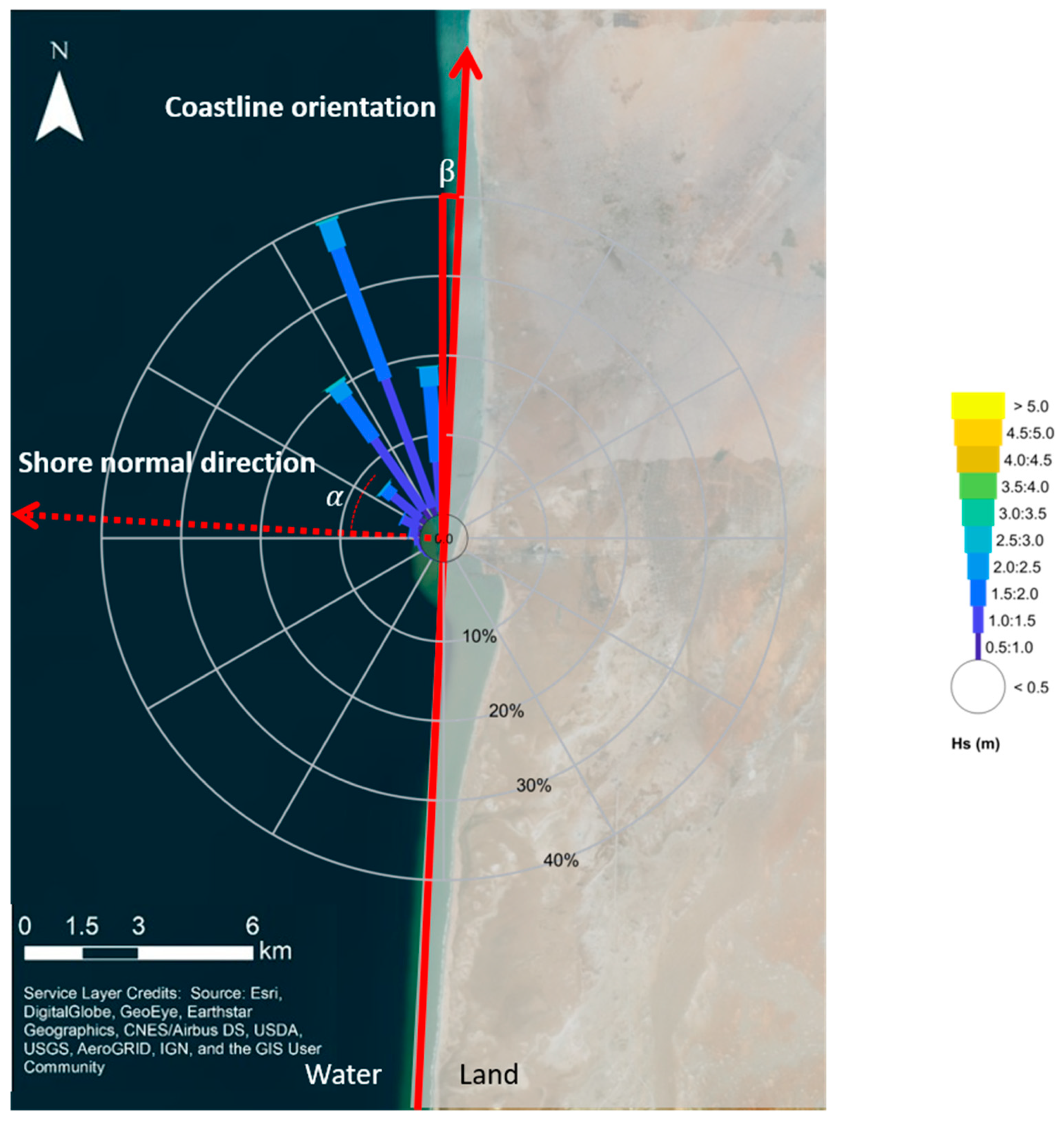
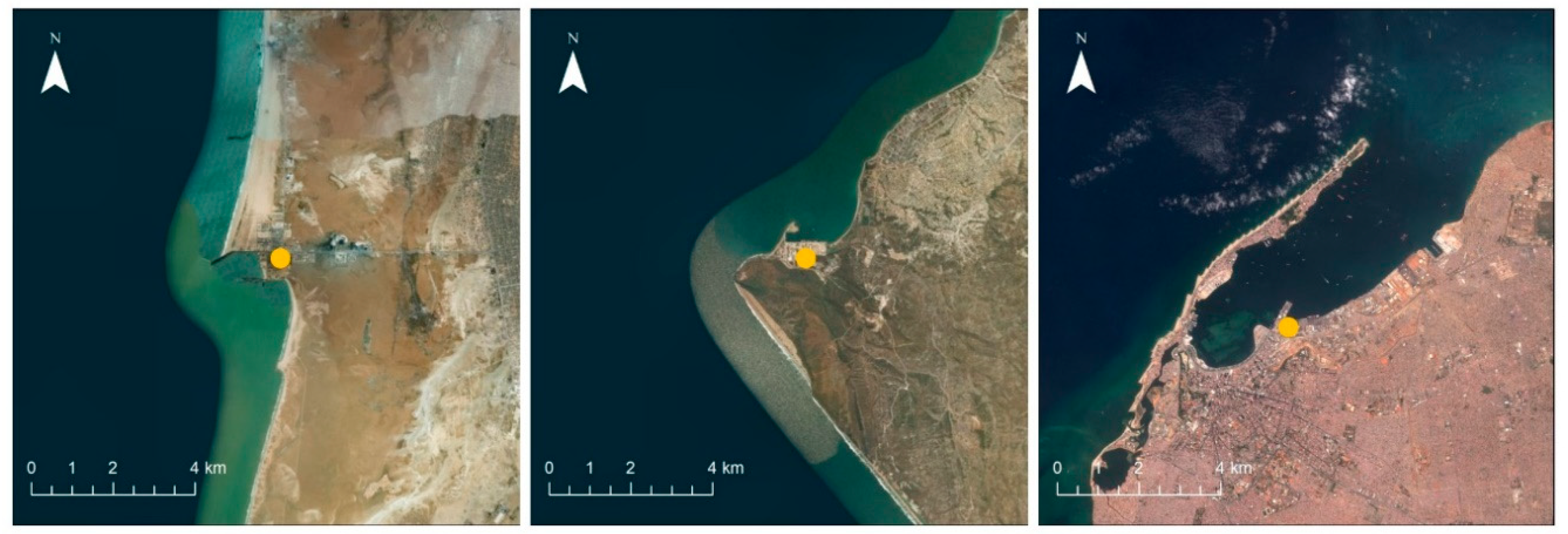
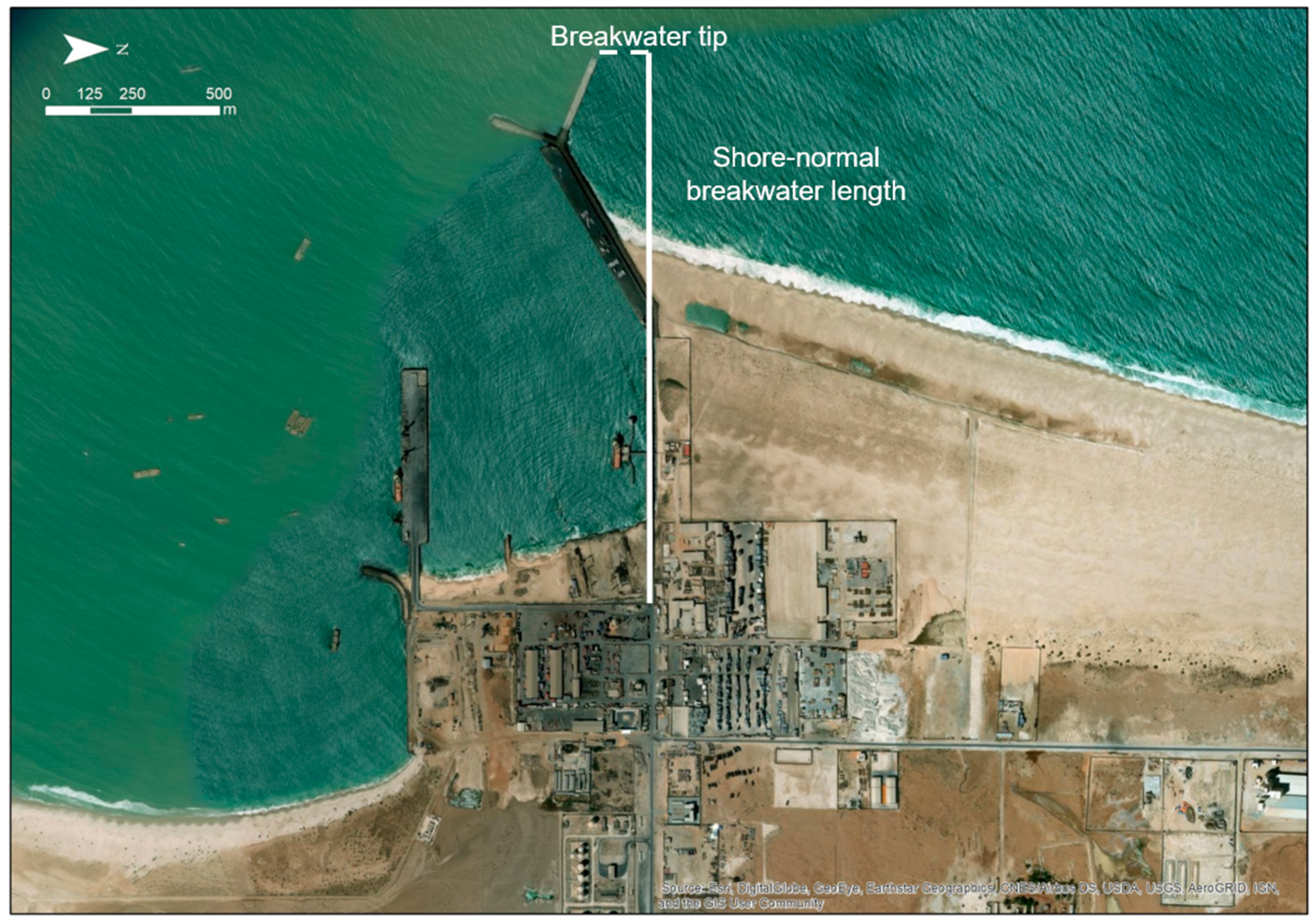
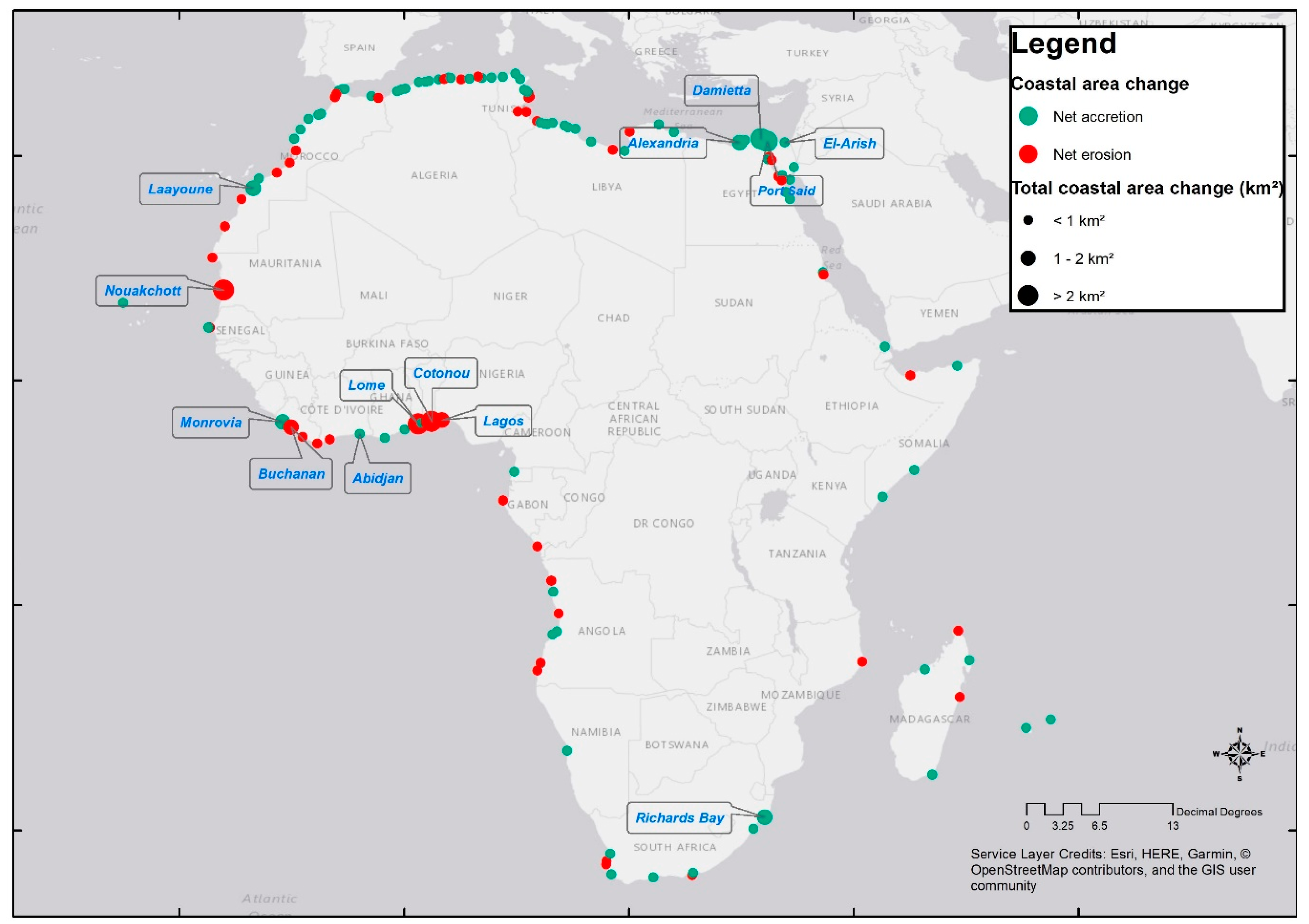
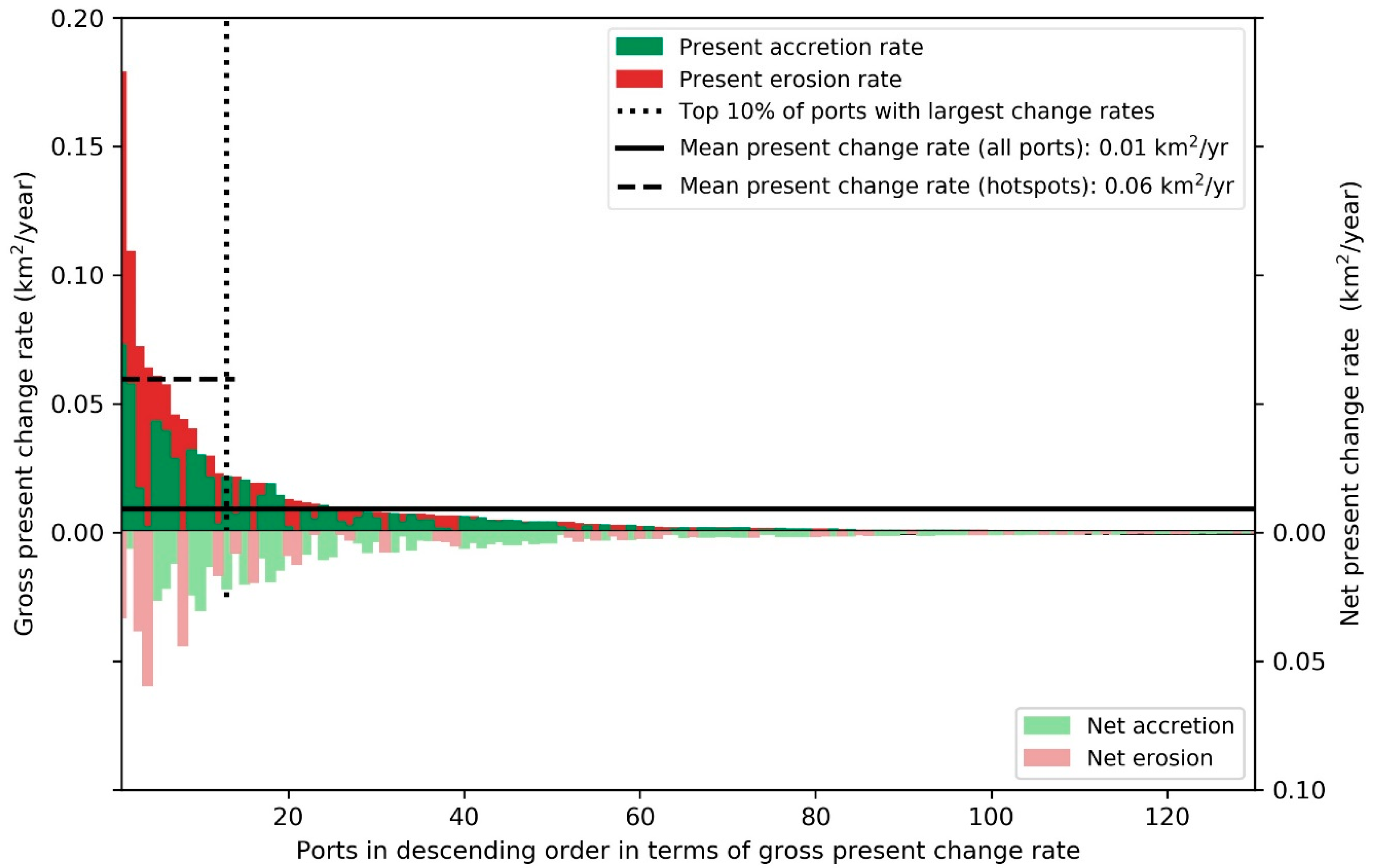
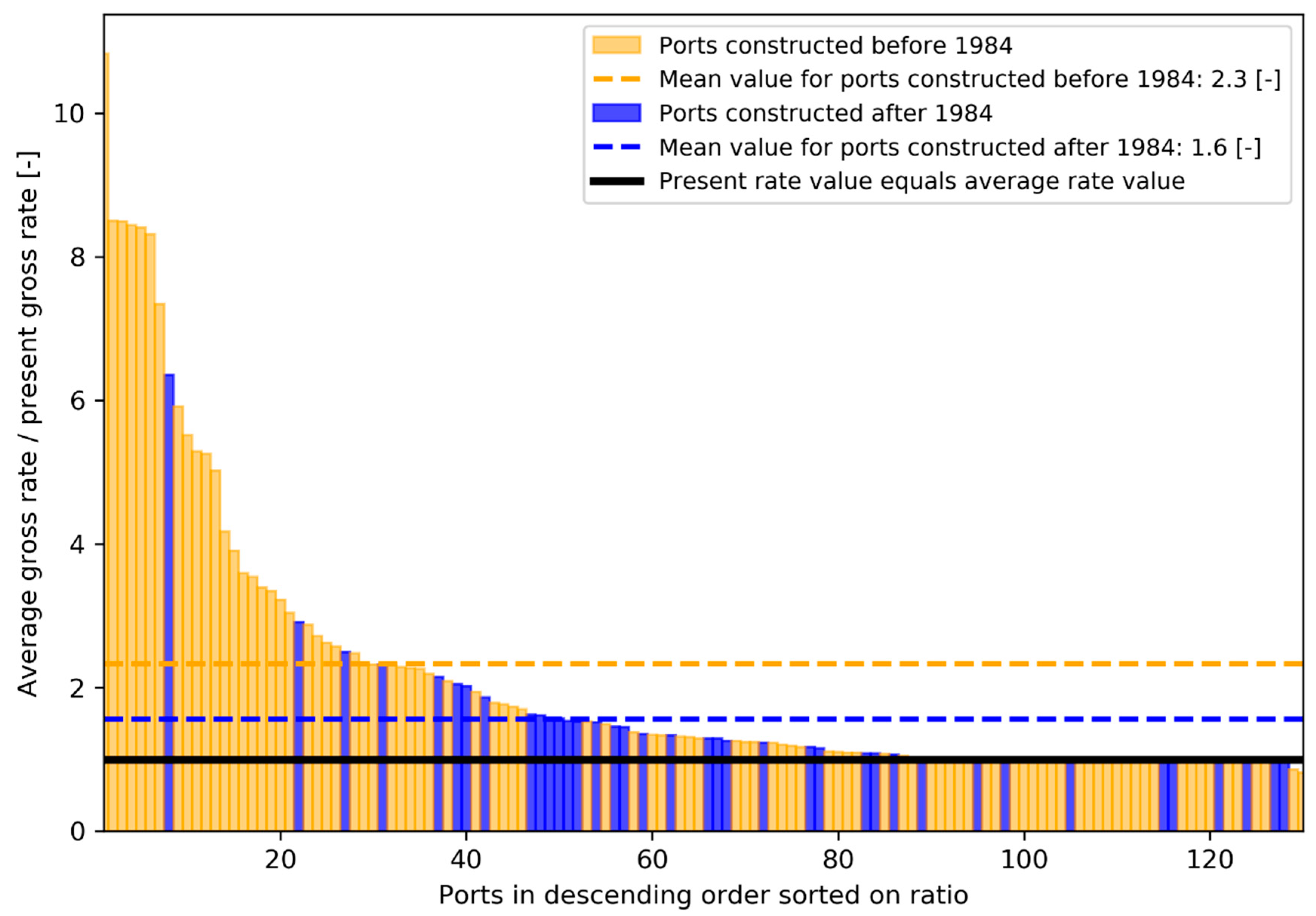
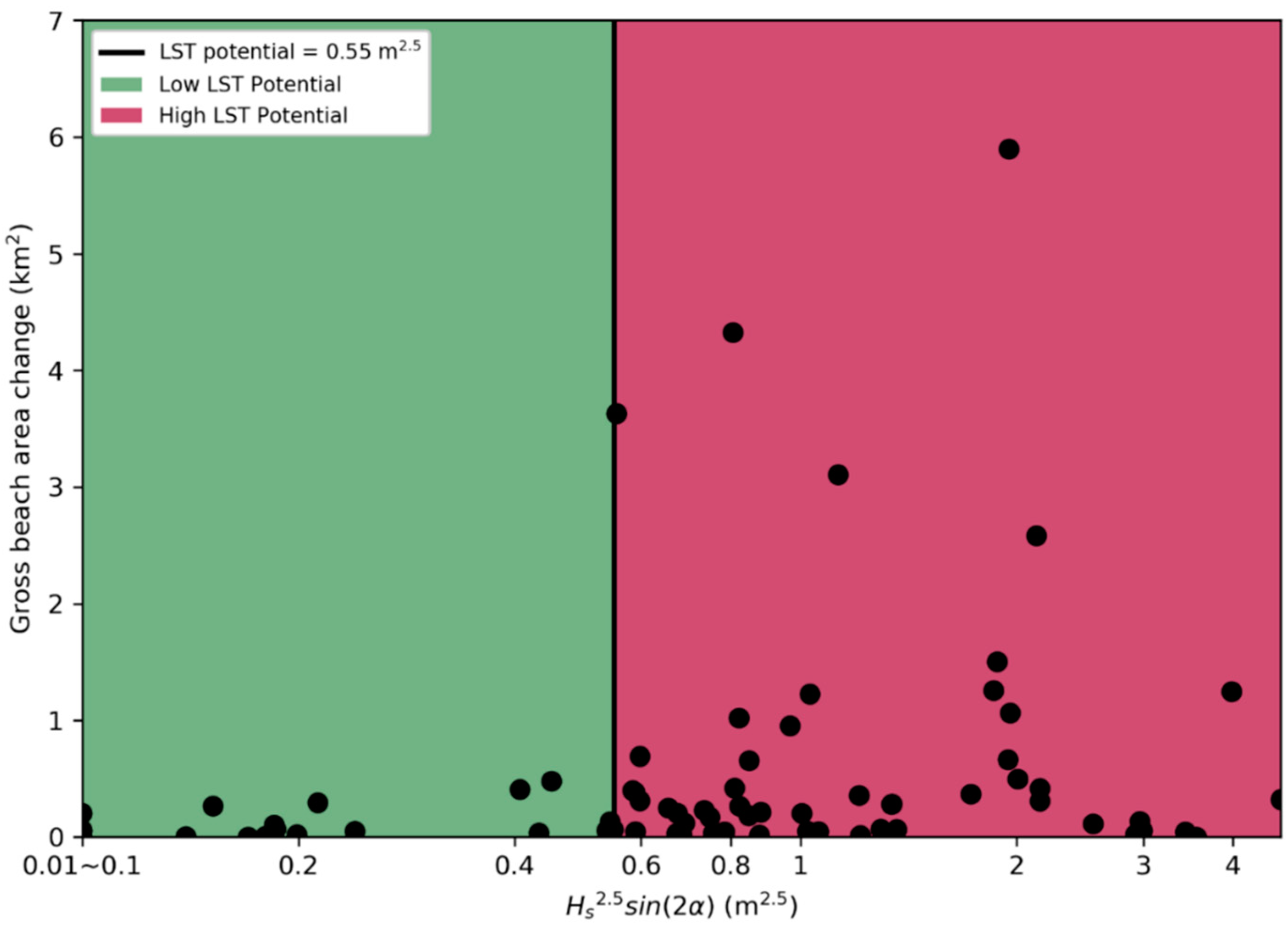
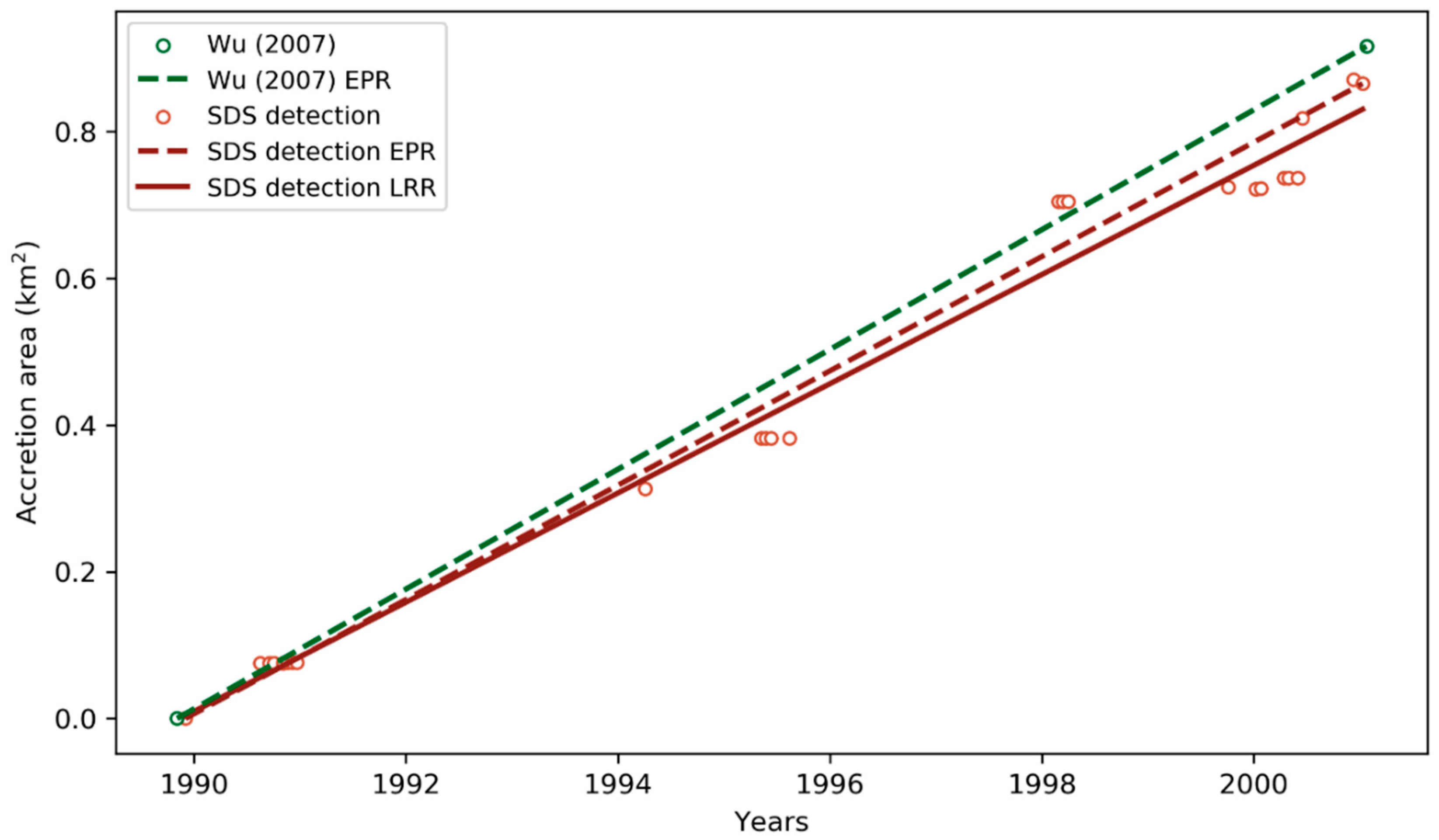
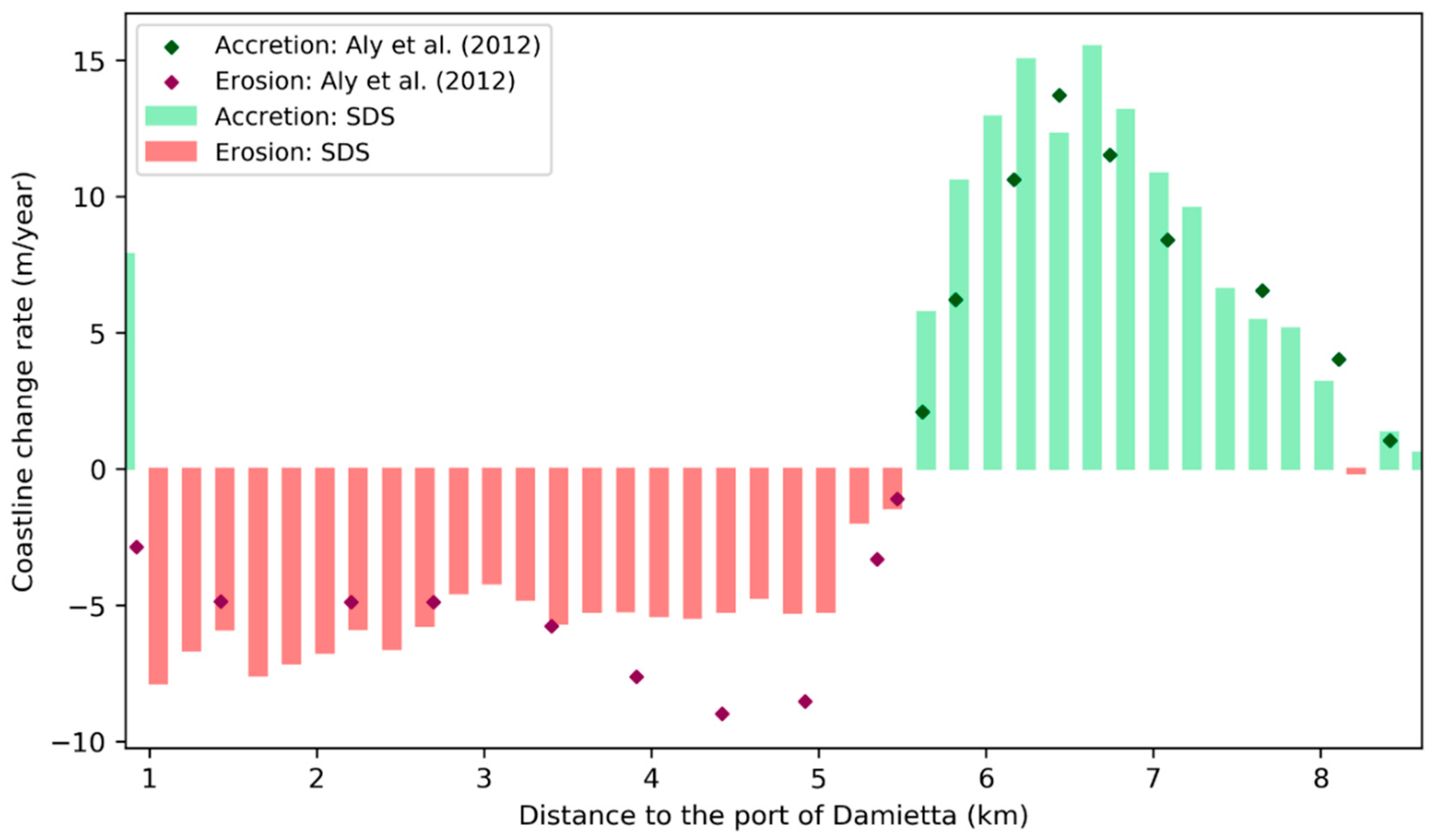
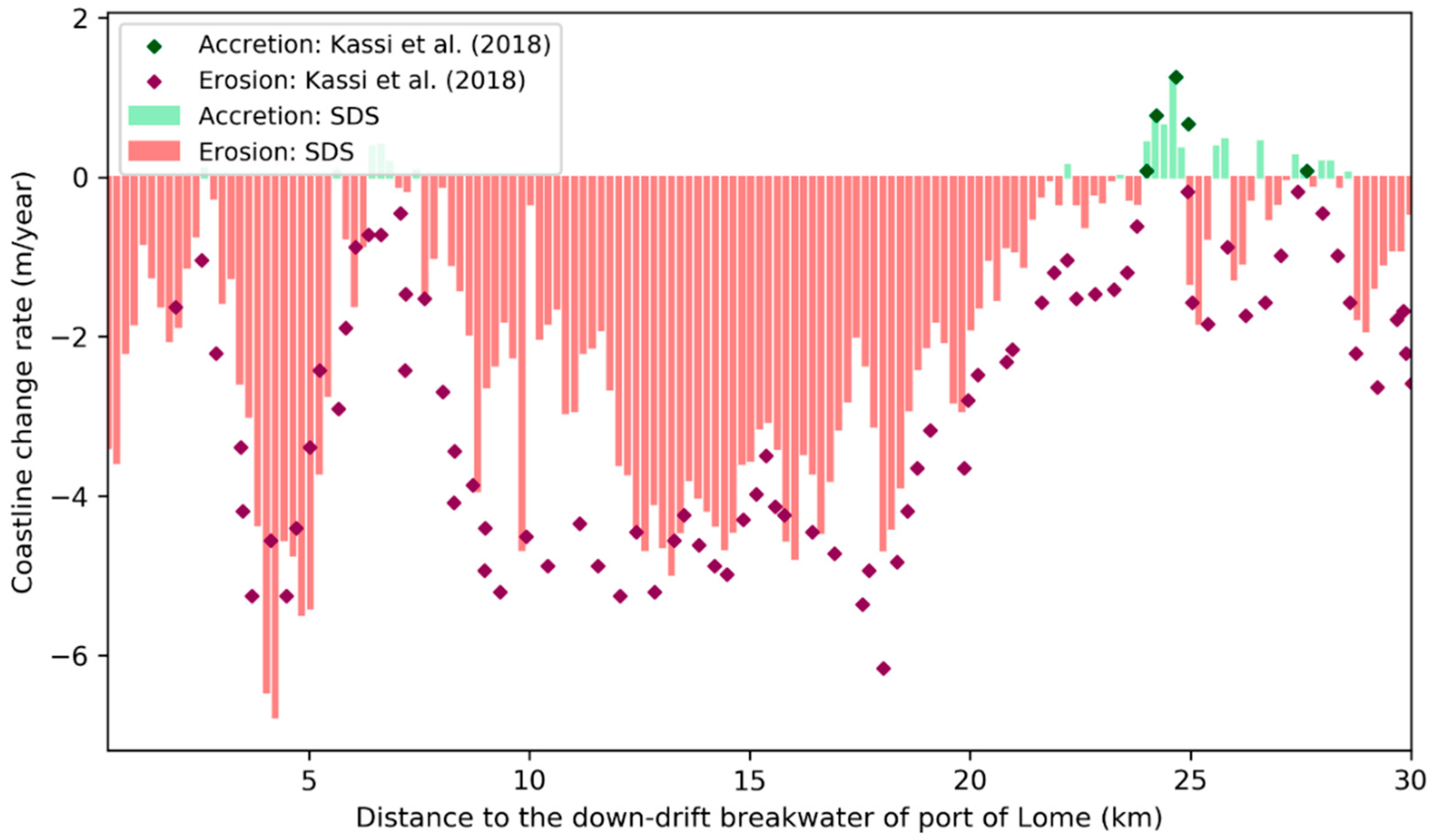
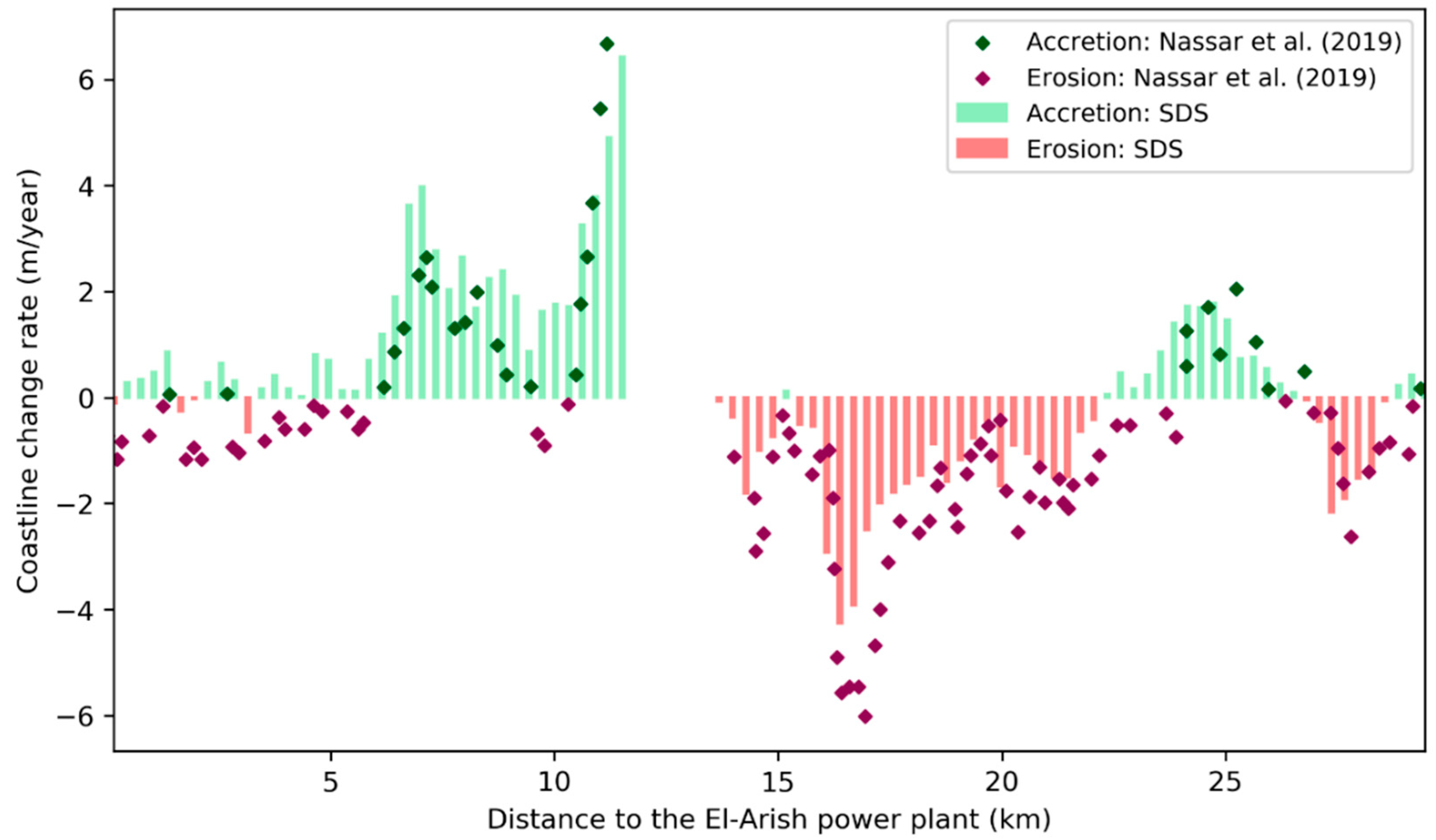
| # | Characteristic | Parameters/Classification | Method/Source | Timeframe |
|---|---|---|---|---|
| 1 | LST potential | : Wave climate (, mean wave direction) | ERA-Interim reanalysis data [38] | 1984–2018 |
| : Coastline orientation | Manually from GE image [30] | 2018 | ||
| 2 | Sediment sources & sinks | Presence of rivers/inlets | Visually from GE image [30] | 2018 |
| 3 | Sheltering setting | Open coasts | Visually from GE image [30] | 2018 |
| Headland-bay coasts | ||||
| Natural barriers | ||||
| 4 | Coastal protection | Dominated by Cross-shore (CS) structures | Visually from GE image [30] | 2018 |
| Dominated by Longshore (LS) structures | ||||
| None | ||||
| 5 | Breakwater length | Shore-normal distance between the landward and seaward breakwater tips | Manually from GE image [30] | 2018 |
| 6 | Construction date | Construction date of port structures | Visually from historical Landsat satellite images [22,30] | 1984–2018 |
| Top 10 Historic Evolution | Total Historic Areal Change (km2) | Top 10 Present Evolution | Present Areal Change Rate (km2/year) |
|---|---|---|---|
| Nouakchott, Mauritania | 5.9 | Nouakchott, Mauritania | 0.18 |
| Cotonou, Benin | 4.3 | Cotonou, Benin | 0.11 |
| Port Said, Egypt | 3.6 | Lagos, Nigeria * | 0.07 |
| Damietta, Egypt | 3.1 | Lomé, Togo | 0.06 |
| Lomé, Togo | 2.6 | Monrovia, Liberia | 0.06 |
| Monrovia, Liberia | 1.5 | Port Said, Egypt | 0.06 |
| Laayoune, Morocco | 1.3 | Idku, Egypt | 0.05 |
| Richards Bay, South Africa | 1.2 | Ambriz, Angola | 0.04 |
| Lagos, Nigeria * | 1.2 | Damietta, Egypt | 0.04 |
| Buchanan port, Liberia | 1.1 | Alexandria, Egypt | 0.03 |
| Ports (#) | Total Gross Beach Area (km2) | Mean Gross Beach Area (km2) | Mean Cross-Shore Change per m (m) | Ratio Accretion/Erosion (-) |
|---|---|---|---|---|
| All (130) | 44.2 | 0.34 | 23 | 1.13 |
| Top 10% (13) | 28.5 | 2.2 | 67.5 | 1.01 |
| Top 1% (1) | 5.9 | 5.9 | 178 | 0.69 |
| Characteristics | Number of Ports (%) | Gross Beach Areal Change | Share of Ports with Net Accretion (%) | Share of Ports with Net Erosion (%) | |
|---|---|---|---|---|---|
| ∑ (%) | (km2) | ||||
| Wave power—LST potential | |||||
| <0.55 (m2.5) | 5% | 10% | 0.09 | 60% | 40% |
| ≥0.55 (m2.5) | 65% | 90% | 0.48 | 66% | 34% |
| Sheltering setting | |||||
| Open coast | 56% | 88% | 0.54 | 60% | 40% |
| Headland-Bay | 30% | 9% | 0.10 | 79% | 21% |
| Behind natural barriers | 14% | 3% | 0.07 | 44% | 56% |
| Sources & sinks | |||||
| Yes | 37% | 58% | 0.53 | 52% | 48% |
| No | 63% | 42% | 0.23 | 71% | 29% |
| Protection structures | |||||
| No structure | 68% | 40% | 0.20 | 57% | 43% |
| Longshore structures | 11% | 5% | 0.16 | 86% | 14% |
| Cross-shore structures | 21% | 55% | 0.86 | 75% | 25% |
| Construction date | |||||
| After 1984 | 29% | 25% | 0.29 | 50% | 50% |
| Before 1984 | 71% | 75% | 0.36 | 70% | 30% |
| Breakwater length | |||||
| <400 (m) | 28% | 7% | 0.08 | 51% | 49% |
| ≥400 (m) | 72% | 93% | 0.44 | 69% | 31% |
| Name | Sheltering Setting | Nearby Rivers/Inlets | Coastal Protection Structures | Construction Date | Breakwater Length (m) | |
|---|---|---|---|---|---|---|
| Nouakchott | ≥0.55 | Open coast | No | Cross-shore | After 1984 | ≥400 |
| Cotonou | ≥0.55 | Open coast | Yes | Cross-shore | Before 1984 | ≥400 |
| Port Said | ≥0.55 | Open coast | Yes | Cross-shore | Before 1984 | ≥400 |
| Damietta | ≥0.55 | Open coast | Yes | Cross-shore | Before 1984 | ≥400 |
| Lomé | ≥0.55 | Open coast | No | No | Before 1984 | ≥400 |
| Monrovia | ≥0.55 | Open coast | Yes | No | Before 1984 | ≥400 |
| Laayoune | ≥0.55 | Open coast | No | No | Before 1984 | ≥400 |
| Richards Bay | ≥0.55 | Open coast | Yes | No | Before 1984 | ≥400 |
| Lagos | ≥0.55 | Open coast | Yes | Cross-shore | Before 1984 | ≥400 |
| Buchanan | ≥0.55 | Open coast | Yes | No | Before 1984 | ≥400 |
| Alexandria | ≥0.55 | Open coast | No | Cross-shore | Before 1984 | ≥400 |
| El-Arish | ≥0.55 | Open coast | No | Cross-shore | After 1984 | ≥400 |
| Abidjan | ≥0.55 | Open coast | Yes | No | Before 1984 | ≥400 |
| Ports | Open Coast | Nearby Rivers/Inlets | Cross-Shore Structures | Before 1984 | Breakwater Length ≥ 400 m | |
|---|---|---|---|---|---|---|
| Hotspots | 100% | 100% | 62% | 54% | 85% | 100% |
| All ports | 65% | 56% | 63% | 68% | 71% | 62% |
| Port | Literature | Time Frame 1 | # Images in Literature (Our Study) 1 | Source of Imagery | Detection Method | Fitting Method 3 |
|---|---|---|---|---|---|---|
| Nouakchott | Wu [9] 2 | 1989~2001 | 4 (38) | SPOT | Image processing | EPR |
| Elmoustapha et al. [44] | 1987~2002 | 4 (60) | SPOT | Visual | EPR | |
| Cotonou | Almar et al. [20] | 1985~2014 | 6 (56) | Landsat | Visual | EPR |
| Said | El Asmar [45] | 1984~1991 | 3 (116) | Landsat | Hybrid | EPR |
| Damietta | Aly et al. [18] 2 | 1993~2000 | 2 (225) | ERS | Radar processing | EPR |
| Lomé | Kassi et al. [21] 2 | 1986~2017 | 5 (125) | Landsat | Image processing | LRR |
| Lagos | Akinluyi et al. [46] | 1984~2016 | 5 (78) | Landsat | Visual | LRR |
| El-Arish | Nassar et al. [47] 2 | 1989~2016 | 10 (695) | Landsat | Image processing | LRR |
| Abidjan | Wognin et al. [48] | 1989~2008 | 2 (59) | Multi | Visual | Unclear |
| Toure et al. [49] | 2003~2009 | 2 (24) | Multi | Visual | EPR |
| Port | Literature | Time Frame (year) | Difference Coastline Change Rate (m/year) | Estimated Positional Difference for Study Timeframe (m) | |
|---|---|---|---|---|---|
| μ | Σ | ||||
| Damietta | Aly et al. [18] | 7 | 2.4 | 2.9 | 16.7 |
| Lome | Kassi et al. [21] | 32 | 1.2 | 0.8 | 38.1 |
| El-Arish | Nassar et al. [47] | 32 | 1.0 | 0.7 | 32.0 |
© 2019 by the authors. Licensee MDPI, Basel, Switzerland. This article is an open access article distributed under the terms and conditions of the Creative Commons Attribution (CC BY) license (http://creativecommons.org/licenses/by/4.0/).
Share and Cite
de Boer, W.; Mao, Y.; Hagenaars, G.; de Vries, S.; Slinger, J.; Vellinga, T. Mapping the Sandy Beach Evolution Around Seaports at the Scale of the African Continent. J. Mar. Sci. Eng. 2019, 7, 151. https://doi.org/10.3390/jmse7050151
de Boer W, Mao Y, Hagenaars G, de Vries S, Slinger J, Vellinga T. Mapping the Sandy Beach Evolution Around Seaports at the Scale of the African Continent. Journal of Marine Science and Engineering. 2019; 7(5):151. https://doi.org/10.3390/jmse7050151
Chicago/Turabian Stylede Boer, Wiebe, Yongjing Mao, Gerben Hagenaars, Sierd de Vries, Jill Slinger, and Tiedo Vellinga. 2019. "Mapping the Sandy Beach Evolution Around Seaports at the Scale of the African Continent" Journal of Marine Science and Engineering 7, no. 5: 151. https://doi.org/10.3390/jmse7050151
APA Stylede Boer, W., Mao, Y., Hagenaars, G., de Vries, S., Slinger, J., & Vellinga, T. (2019). Mapping the Sandy Beach Evolution Around Seaports at the Scale of the African Continent. Journal of Marine Science and Engineering, 7(5), 151. https://doi.org/10.3390/jmse7050151






